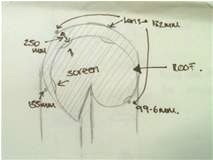To develop the design of my model I have decided to use 3D software. I have chosen to use Google Sketch Up to draw up the design. As I have not used any kind of 3D software before I have had to acquire new skills to create the 3D model. It has been worthwhile to work with the design of my model in 3D as it has allowed me to look at my model from more angles, where I have gained better knowledge as to how my structure will actually come together.
I have decided to construct my camera obscura structure so that it can be dismantled after my degree show. This gives my structure a life after the show, as it can then be erected again in different locations. My structure is a site specific piece of work however, it becomes a site specific installation where ever it is erected.
I initially decided to split my structure into three sections vertically, however after some deliberation I came to the conclusion that it would be better to construct the structure in horizontal sections. This means that the curve of the spiral will remain consistent during its life time, where as if the spiral consisted of three vertical sections there would be a chance the curve may not line up correctly and would therefore not be as aesthetic for the viewer.
The design above shows the spiral structure made from two horizontal sections, each section being 4' tall. This is due to the plywood coming in 8' by 4' boards. However, I am going to make the sections only 2' tall, this means each horizontal section will be easier to move and can be transported easier. The design for this model can be seen below.
From looking at where my piece is going to be installed I have decided to place a lens in the roof of the structure. As there is a glass roof in the gallery this creates a nice composition, this lens will be placed in the centre of the spiral. As it would be rather difficult to construct a curved roof on a curved structure I am going to place a lens with a small focal length on the roof. As the structure will be 8' tall people will not the able to see this added section and won't ruin the aesthetics of the construction. The image below shows where the lens will be placed, these will be at varying heights and varying distances apart. However, I still need to experiment with how the lenses will interact with each other. So far I have only used one lens in a camera obscura, therefore I am unsure of the results will multiple lenses.













